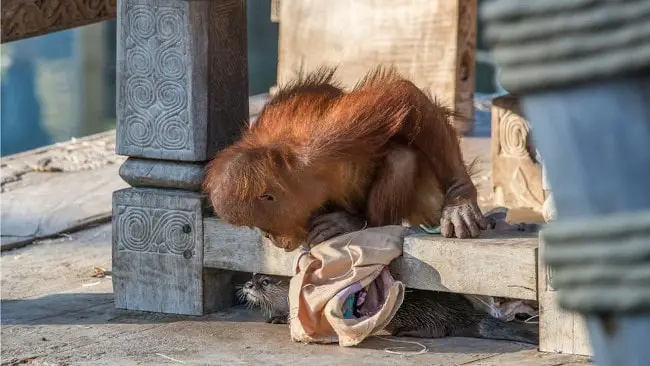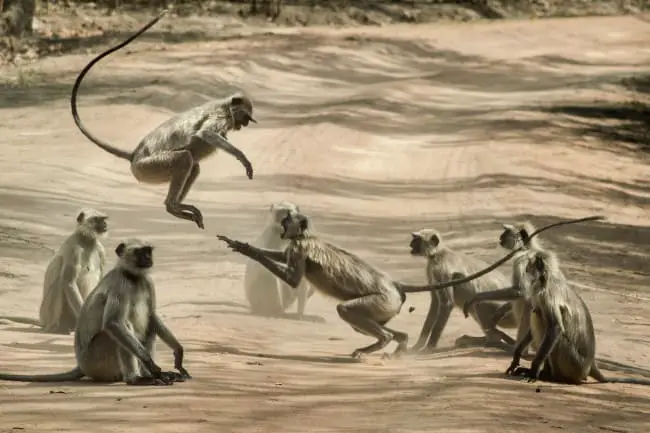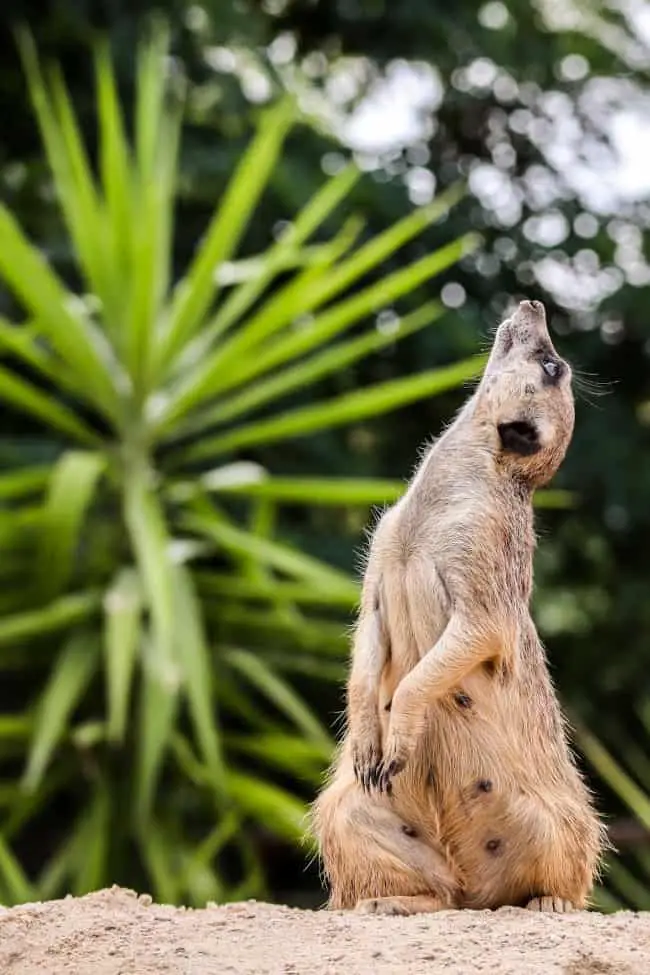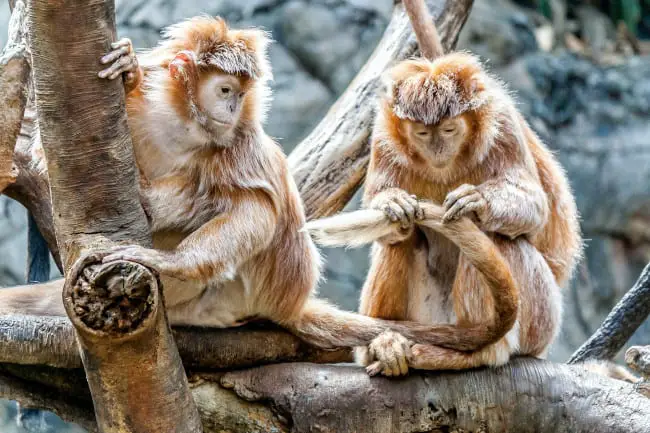It is best practice in zoos to keep animals in their natural social groups as far as possible. Social groups stimulate many important behaviours for good animal welfare. But it is not always possible to keep the complete natural social structure of groups of animals in captivity, due to lack of space or availability of animals. Social enrichment is an exciting way to stimulate these social behaviours, especially when social structures are not the same as their wild conspecifics. Social enrichment is often an underused category of the enrichment repertoire, as seen in the study of Hoy, Murray and Tribe, 2010. Nevertheless, it is valued as very important in the same survey. So let’s have a closer look at social enrichment and enriching social groups of animals.

What is social enrichment
Before talking about how to use social enrichment and enrichment in social groups, we first have to have a clear definition of what social enrichment actually is.
The meaning of social enrichment consists of two leading practices and are defined as: Social enrichment consists of housing a group of conspecifics (social group) or animals of different species that would encounter in the wild as well (mixed-species groups), and secondly social enrichment consists of stimulating species-specific social behaviours like feeding, foraging, territoriality, reproduction and courtship. Human-animal interaction can also be seen as a form of social enrichment.

Social enrichment is a broad topic and is not applied only by forming groups of animals. When I was searching for examples and studies of social enrichment, I was shocked about the little results there is. It is not described that much on the internet or papers, and also examples of social enrichment devices are not easily be found. However, you have to keep in mind when we talk about categories of enrichment, enrichment devices are not often assigned only to one category (so, it is not only called ‘social enrichment’). On the other hand, we must not underestimate the value of social enrichment. In a study on zoo elephant welfare, it even states that ‘social interactions and enrichment activities are more important than enclosure size‘. But first, what forms are there of social enrichment?

Forms of social enrichment
You can apply social enrichment in many forms. Zoos attend to keep animals in their natural social groups. You do not see a meerkat or spider monkey alone in an enclosure. Okay, I agree; also solitary animals are often kept in couples as this is also a necessity when you want to breed with an animal (which is also an important social behaviour). So, in what way can social enrichment be applied, starting with the most obvious form: keeping animals in their natural social group.
Social groups of conspecific animals
Maybe for many obvious, but when social animals are kept in isolation is a prominent risk factor for their well-being. Often you see the development of abnormal behaviour or exclusion of essential behaviours that are usually expressed in the animal’s behavioural repertoire. Zoos tend to keep animals in natural group size with a sex-ratio and hierarchy as seen in the wild. In this way, you promote the best social interaction and stimulate natural behaviours important to the animal. With meerkats for example, it is good to have a larger group of animals with a partly equal sex-ratio and a leading alfa couple. These animals will experience less stress when sleeping or foraging because often one (lower ranked) animal takes the watch for the group. Off course, in such a group is also some portion of stress or aggression from time to time, but that is entirely natural and can also be seen as social behaviours. The same for flamingos, which are also best kept in large groups, for often the same reasons as meerkats. And with many hoofed mammals, the rules apply for them too! Maybe this all sounds very obvious, but don’t underestimate the importance of keeping animals in social groups. On the other end of the equation are solitary animals that are kept in couples or (single-sex) groups in zoos for management or breeding reasons. This will give completely other challenges, though this topic is one that is not discussed here and should have attention another time.
Animals in mixed exhibits
I once saw an exhibit with one scarlet macaw, three African spurred tortoises, two huge green iguanas and a hundred guinea pigs. Strange combination, right? I was told that it worked fine and sometimes there was friendly interaction between different species. It is called a mixed exhibit, but most often mixed-exhibits consist of different species of animals that would encounter in the wild as well. A mixed exhibit is an excellent opportunity for interspecies interaction and social enrichment. Think of defending young or defending nests/burrows? Or the food hierarchy between species and their foraging strategy to acquire the offered food to avoid conflict and ensure to collect enough food. But some species will also sleep together for better protection, warmth or sometimes just because they can or want to. And from a behavioural point of view, it creates many more stimulations, changes and complexity in the environment, which ultimately benefits all the animals. To a certain extent, because we must not forget that over time these animals will become habituated to each other and thereby it will not be that enriching anymore. To conclude, and almost needless to say, but not all combination works well of course. Some animals will (eventually) kill the other or one species will live while continuously experiencing a high level of stress resulting in behavioural problems and a low level of welfare.
Human-animal interaction
It is sometimes discussed if human-animal interaction is social enrichment, but for the context of this article, we consider it does. This kind of enrichment (almost) only applies to animals under human care. One of the most known interaction is animal training. It can be considered as enrichment because of the mental stimulation that is providing and cognitive challenges as we humans create for the animal. Wild Enrichment and Zoospensefull extensively describe how animal training can function as an enrichment tool. With some animals, most seen with pets and domestic farm animals, humans can provide social interaction as cuddling, attention and be a companion. This interaction is not possible in the case, or is not wanted, for most zoo (wild) animals. However, there is one enriching aspect that we must not forget in zoos: visitors. I must be honest; sometimes, it is not that beneficial and have definitely its downsides, but visitors are an everchanging stimuli in the environment of animals. Especially with walkthrough exhibits or in front of large glass panels.
Other forms of social enrichment
There are some other forms of enrichment, more in the form of devices that can be used to trigger some behaviour. One of the more known and commonly used are mirrors, for example for primates or birds, but can also be interesting for dolphins or elephants. Mirrors can be triggering some fascinating behaviours and with behaviours like daunting, threaten and attacking, which are completely normal natural behaviours to express, are not inflicting any damage or harm to other animals. Although, you need to be careful that it is not harming or damaging the animal itself when doing these behaviours to a mirror. By the way, be aware that large glass panels in exhibits can be reflective as well depending on the lightning or sun. In one case, I know an elephant male was pretty stressed every time he saw his reflection in the windows, to such an extent that the windows were stickered with anti-reflection. Another way of social enrichment are look-a-likes or plush toys. For example, when humans nurse a young penguin to accept fish-feeding by hand, a plush toy penguin can be very beneficial for “social contact” with the animal when it is mostly alone. This enrichment tool can also be helpful for rejected young animals by their parents so that they will be less focused on humans.

Enriching social groups
So in the first section, we discussed what forms of social enrichment there is to stimulate social behaviours. But there is one other important part to consider as well. We already stated how important it is to keep animals in their natural social structure. But with social groups, there are also particular challenges when managing the animals, even so with animal training and enrichment practices. For the extent of animal training, we will not discuss it here, but Zoospensefull has a helpful article about training animal groups. When enriching a group of animals, you need to consider a few things.
Social structure and hierarchy
Within every group of animals, even with unnatural group structure (e.g. single-sex groups or breeding group of solitary animals), there is a certain hierarchy. It is not always visible at once, but there is still one animal more dominant than the other. When an animal is not allowed to certain enrichment and stimuli, it can be frustrating to an animal and can cause stress when not allowed to explore new or novel objects or parts of the exhibit. You have to take it into account when providing enrichment, especially when giving food enrichment. It must not be that only one animal claims and eats all the food, right?
Enrichment monopolization
An issue we all no doubt come across: who is hogging all the enrichment items? Enrichment monopolization is the phenomenon of claiming the new, interesting or rewarding part in the exhibit by a predominantly character in the group. This monopoly over the enrichment can be frustrating to the other animals and makes the enrichment effort not effective to the whole group. In a certain extent, it is no problem that this behaviour occurs and can even be good for keeping the social structure clear. But when the same individual is continuously parading the enrichment is pretty frustrating to other group members or even induce aggressive behaviours. When enrichment is offered that is stationary, it is often fine to add only one or few of these items. When it can be claimed and is portable, it is important to consider the rule “give more items than animals”. Aiming to provide enough quantity, so other less dominant animals still get a fair share too. Monopolization can be very problematic in a group of animals, even to the extent that animals express abnormal behaviours right at the moment that you provide enrichment. Static or unmovable enrichment can also be designed in such a way that multiple animals can use it to prevent monopolization.
Group composition change?
Sometimes and with some animals, it is possible to change the group composition temporarily. IMPORTANT: Careful considerations must be taken when you do this. With some animals, it is highly unadvisable to do so. For example, a group of chimpanzees should not be changed on a semi-regular basis. Group members can be kicked out, and it will be hard to reintroduce. But for some animals, you can sometimes split the group and reunite them after a certain time. Or within mixed-exhibits, sometimes have one mixed-composition, sometimes another or sometimes split. With for example Siberian tigers, you can split them for the night (or a day) and reunite them afterwards. However, always take careful consideration when you do some group composition change.
Cooperative enrichment
Another completely different principle is cooperative enrichment. This kind of enrichment stimulates cooperation between animals to get their reward. It is an enrichment device designed in such a way that it needs more than one individual to get the food. This enrichment device can be of interest to animals that are willing to cooperate for each other’s benefit. In other words, animals that have a natural form of altruism: a principle or practice of concern for other animals happiness or benefit. There is a great study done to this way of enrichment, by dogs and wolves, which shows that wolves are more socially cooperative than dogs. It would be interesting to develop this concept more in enrichment with some animals. I challenge you to think about it, make a design and test this way of enrichment to a species known to be cooperative and have a certain level of altruism. Please let me know your experience.
Wrapping up
We covered a lot in this article. To summarize, social enrichment can be formed in four ways: normal (natural) social groups, interspecies groups, human-animal interaction and substituted social enrichment. When enriching social groups, you need to consider its group structure and hierarchy and be aware of monopolizing enrichment items and devices. But on the opposite side, you can also stimulate cooperation and use the natural altruism that some animals have. In zoos, you will most likely be confronted in some way with social enrichment. With better understanding and a dose of inspiration, you will be able to apply social enrichment more and/or be able to make better consideration when enriching social groups. If you miss any information or have a question, I will gladly see your comment in the section below. I would also be thrilled to read your experience with social enrichment or enriching social groups.
Share this page!